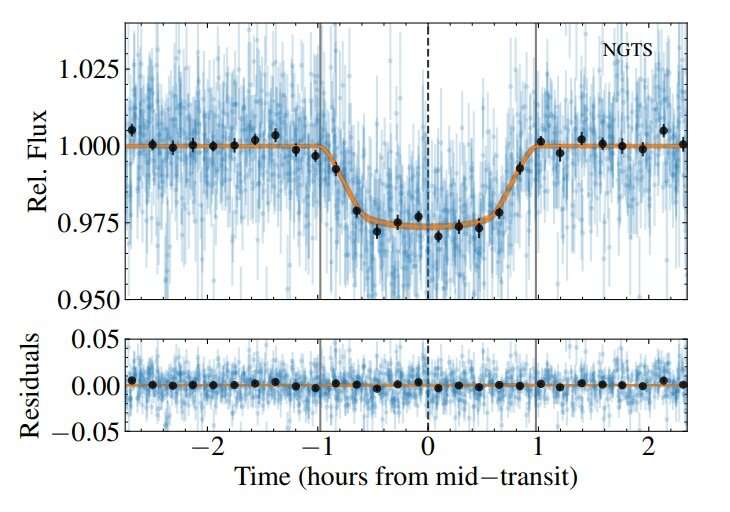October 13, 2022 report
Astronomers detect an inflated 'hot Jupiter' exoplanet

An international team of astronomers has discovered a new inflated "hot Jupiter" exoplanet as part of the Next Generation Transit Survey (NGTS). The newfound alien world, designated NGTS-21b is about 30% larger and more than two times as massive as Jupiter. The finding was detailed in a paper published October 3 on arXiv.org.
The so-called "hot Jupiters" are similar in characteristics to the solar system's biggest planet, but have orbital periods of less than 10 days. Such exoplanets have high surface temperatures, as they orbit their parent stars very closely.
Now, a group of astronomers led by Douglas R. Alves of the University of Chile in Santiago, Chile, reports the detection of a new extrasolar planet of this type. While observing a metal-poor K dwarf star known as NGTS-21 using telescopes operating from the ESO Paranal Observatory in Chile, they identified a strong transit signal. Planetary nature of this signal was confirmed by follow-up observations.
"NGTS-21 was observed during the 2018 campaign from March 24 to November 7, where 9157 images were obtained during 150 nights, with 10s exposure time per frame.... A strong signal was detected at 1.543 days, and a validation process began in order to either confirm the signal as a likely transiting hot Jupiter or reject it as a false positive detection," the researchers explained.
NGTS-21b has a radius of 1.33 Jupiter radii and a mass of 2.36 Jupiter masses, which yields a density at a level of 1.25 g/cm3. The planet orbits its host approximately every 37 hours, at a distance of some 3.5 million kilometers from it. Therefore, it means that NGTS-21b is exceptionally hot—its equilibrium temperature is estimated to be around 1,357 K.
The scientists underlined that the parameters of NGTS-21b indicate that it is an inflated massive hot Jupiter. This is due to the fact that some giant planets expand in size when their parent stars are at the end of their lives and NGTS-21 is estimated to be 10 billion years old.
The inflated planets have been known to astronomers for almost two decades, but it is still unclear what causes the inflation processes. In general, the possible explanations could be assigned to two theories—scientists believe that the inflation is caused by deposition of energy from the host star, or due to inhibited cooling of the planet.
"Inflation-free planetary structure models suggest the planet's atmosphere is inflated by about 21%, while inflationary models predict a radius consistent with observations, thus pointing to stellar irradiation as the probable origin of NGTS-21b's radius inflation," the astronomers wrote, trying to find the most plausible explanation for the inflation of the newfound alien world.
The authors of the paper also revealed fundamental properties of the parent star NGTS-21. According to the study, it is a metal-poor dwarf of K3V spectral type, located some 2,090 light years away from the Earth. The star is 14% smaller and nearly 30% less massive than the sun. The effective temperature of NGTS-21 was measured to be 4,660 K.
More information: Douglas R. Alves et al, NGTS-21b: An Inflated Super-Jupiter Orbiting a Metal-poor K dwarf. arXiv:2210.01027v2 [astro-ph.EP], arxiv.org/abs/2210.01027
© 2022 Science X Network





















